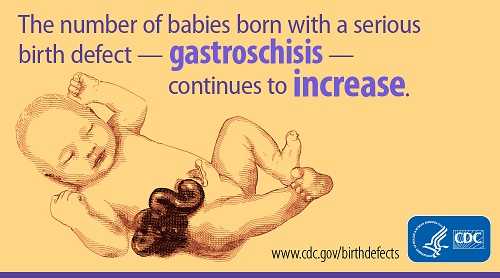Key Findings: Gastroschisis – a Serious Birth Defect - Continues to Increase
New CDC research shows that the occurrence of gastroschisis, a birth defect where a baby’s intestines stick outside of the body through a hole beside the belly button, continues to increase over time. Importantly, the causes for the continued increase in the number of babies born with gastroschisis are unknown, and public health research is urgently needed to uncover more clues. You can read the article at www.cdc.gov/mmwr or read more below for a summary of this study’s findings.
What did we already know?
Since the 1980s, the number of babies born with gastroschisis has increased, especially among young mothers. A previous study showed that gastroschisis nearly doubled from 1995-2005. The causes of this increase and whether the increase has continued more recently was unknown.
What were this study’s main findings?
- The highest prevalence of gastroschisis occurred in teen mothers (younger than 20 years old). The increase in gastroschisis prevalence among teen mothers is not related to the birth rate for teen mothers, which has actually declined over the same time period.
- Gastroschisis has continued to increase in the most recent years. The prevalence of gastroschisis increased from 1995 to 2012 among mothers in every age group and for each racial/ethnic group that was studied (non-Hispanic whites, non-Hispanic blacks, and Hispanics).
- The largest increase in gastroschisis was among babies born to non-Hispanic black mothers younger than 20 years of age.
About this Study
Researchers used data from population-based birth defects tracking programs in 14 states. Participating states were Arizona, Arkansas, California, Colorado, Georgia, Iowa, Kentucky, New Mexico, New York, North Carolina, Oklahoma, Rhode Island, Texas, and Utah. In this study, researchers looked at the prevalence of babies affected by gastroschisis in these 14 states and trends in gastroschisis over time.
CDC’s Activities: Birth Defects
CDC is working to address birth defects, like gastroschisis, with the following activities:
- Tracking: CDC tracks birth defects through several state tracking systems and regional programs. CDC also supports and collaborates with the National Birth Defects Prevention Network (NBDPN), a volunteer-based organization consisting of local, state, and national groups working on birth defects monitoring, research and prevention. For this study, researchers collaborated through the NBDPN to collect the data from the 14 different states.
- Research: CDC funds the Centers for Birth Defects Research and Prevention, which collaborate on large studies such as the National Birth Defects Prevention Study (NBDPS) (births 1997-2011) and the Birth Defects Study To Evaluate Pregnancy exposureS (BD-STEPS) (began with births in 2014). These studies work to identify factors that increase the risk for birth defects.
More Information
For more information about gastroschisis or to read about families affected by gastroschisis, visit the following webpages:
- CDC’s Facts about Gastroschisis
- Gastroschisis Stories on CDC’s Real Stories webpage
- Avery’s Angels Gastroschisis Foundation
References
Jones AM, Isenburg J, Salemi JL, Arnold KE, Mai CT, Aggarwal D, Arias W, Carrino GE, Ferrell E, Folorunso O, Ibe B, Kirby RS, Krapfl HR, Marengo LK, Mosley BS, Nance AE, Romitti PA, Spadafino J, Stock J, Honein MA. Increasing Prevalence of Gastroschisis — 14 States, 1995-2012. MMWR Morb Mortal Wkly Rep. 2016
- Page last reviewed: January 21, 2016
- Page last updated: January 21, 2016
- Content source:


 ShareCompartir
ShareCompartir
